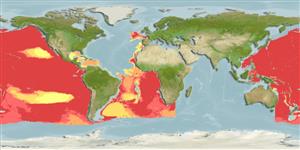>
Lophiiformes (Anglerfishes) >
Linophrynidae (Leftvents)
Etymology: Photocorynus: Greek, 'phos' or 'photos' = light + Greek, 'koryne' = club or mace (alluding to the unusually short and clublike illicium and esca of the genus) (Ref. 86949).
More on author: Regan.
Environment: milieu / climate zone / depth range / distribution range
Ecología
marino batipelágico; rango de profundidad 990 - 1420 m (Ref. 86949). Deep-water
Western Atlantic: in tropical and subtropical waters. Also known from both sides of the Pacific Ocean.
Tamaño / Peso / Age
Maturity: Lm ? range ? - ? cm
Max length : 1.0 cm TL macho / no sexado; (Ref. 10762); 4.3 cm (female)
Short description
Claves de identificación | Morfología | Morfometría
Metamorphosed females distinguished by the following characteristics: have spine on epiotic, pair of spines on postemporal and 5-6 spines on preopercle; frontals meet on midline, each with well-developed anterodorsal spine; moderately strong maxillae, jaws with numerous short teeth arranged in several series; absence of vomerine teeth; presence of first pharyngobranchial; ceratohyal lacking anterodorsal process; posterior margin of hypural plate is entire; extremely short ninth caudal fin ray, length of illicium less than 10%SL; esca nearly sessile on snout, without appendages; absence of hyoid barbell; second and third pectoral radials are subequal; darkly pigmented skin. Free-living juvenile males characterized by: lacking cranial and preopercular spines; preopercle not strongly curved; epiotic region of skull highly elevated; 8-9 teeth on each side of upper and lower jaws, all shorter than the denticular teeth; small denticular bones, placed slightly behind tip of jaws; slender denticular teeth, 3 on upper denticular and 3-4 on lower denticular; slightly tubular eyes, diameter 8-9% SL; moderately enlarged and inflated olfactory organs, nearly as large as eyes; 3 olfactory lamellae; skin unpigmented. Adult males characterized by: having skin that is very faintly pigmented; olfactory organs and to a lesser extent the eyes are degenerated; jaw teeth lost except in the lower jaw of one known specimen (Ref. 86949).
Also mesopelagic. Males dwarfed, becoming parasitic on females (Ref. 10762).
Life cycle and mating behavior
Maturities | Reproducción | Spawnings | Egg(s) | Fecundities | Larva
Bertelsen, E., 1990. Linophrynidae. p. 516-519. In J. C. Quero, J. C. Hureau, C. Karrer, A. Post and L. Saldanha (eds.) Check-list of the fishes of the eastern tropical Atlantic (CLOFETA). JNICT, Lisbon; SEI, Paris; and UNESCO, Paris. Vol. 1. (Ref. 10762)
IUCN Red List Status (Ref. 130435)
Threat to humans
Harmless
Human uses
Herramientas
Special reports
Download XML
Fuentes de Internet
Estimates based on models
Preferred temperature (Ref.
123201): 2.4 - 3.5, mean 3.1 °C (based on 17 cells).
Phylogenetic diversity index (Ref.
82804): PD
50 = 1.0000 [Uniqueness, from 0.5 = low to 2.0 = high].
Bayesian length-weight: a=0.01995 (0.00906 - 0.04395), b=3.01 (2.83 - 3.19), in cm total length, based on all LWR estimates for this body shape (Ref.
93245).
Nivel trófico (Ref.
69278): 3.7 ±0.6 se; based on size and trophs of closest relatives
Fishing Vulnerability (Ref.
59153): Low vulnerability (10 of 100).
